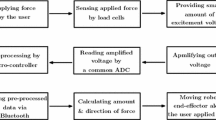Abstract
A stiffness decoupling 8/4-4 parallel force sensing mechanism (PFSM) is presented. Its mathematic model is established with screw theory. The force mapping relation is studied and the stiffness matrix is found to be a diagonal matrix, which proves the stiffness decoupling characteristics of the mechanism. According to the concept of fully isotropy, the isotropy conditions are analyzed, the parameters which meet fully isotropy are given. The 8/4-4 PFSM’s configuration under isotropy parameters is analyzed. Based on this configuration, an 8/4-4 mechanism cluster which meets the fully isotropy is presented. The cluster’s configuration is classified and induced into four main configurations according to the different parameter conditions.
Access this chapter
Tax calculation will be finalised at checkout
Purchases are for personal use only
Similar content being viewed by others
References
Dong, Y., Gao, F., Yue, Y.: Modeling and experimental study of a novel 3-RPR parallel micro-manipulator. Robot. Comput. Integr. Manufact. 37, 115–124 (2016)
Liang, Q., Zhang, D., Chi, Z., Song, Q., Ge, Y., Ge, Y.: Six-DOF micro-manipulator based on compliant parallel mechanism with integrated force sensor. Robot. Comput. Integr. Manufact. 27, 124–134 (2011)
Ren, X.D., Feng, Z.R., Su, C.P.: A new calibration method for parallel kinematics machine tools using orientation constraint. Int. J. Mach. Tools Manufact. 49, 708–721 (2009)
Portman, V., Sandler, B.Z., Chapsky, V., Zilberman, I.: A 6-DOF isotropic measuring system for force and torque components of drag for use in wind tunnels. Int. J. Mech. Mater. Des. 5, 337–352 (2009)
Almeida, R.A.B., Vaz, D.C., Urgueira, A.P.V., Borges, A.R.J.: Using ring strain sensors to measure dynamic forces in wind-tunnel testing. Sens. Actuators A Phys. 185, 44–52 (2012)
Gaillet, A., Reboulet, C.: An isostatic six component force and torque sensor
Kerr, D.R.: Analysis, properties, and design of a stewart-platform transducer. J. Mech. Des. 111, 25–28 (1989)
Dwarakanath, T.A., Venkatesh, D.: Simply supported, ‘Joint less’ parallel mechanism based force–torque sensor. Mechatronics 16, 565–575 (2006)
Yao, J., Hou, Y., Chen, J., Lu, L., Zhao, Y.: Theoretical analysis and experiment research of a statically indeterminate pre-stressed six-axis force sensor. Sens. Actuators A Phys. 150, 1–11 (2009)
Yao, J., Hou, Y., Wang, H., Zhou, T., Zhao, Y.: Spatially isotropy configuration of Stewart platform-based force sensor. Mech. Mach. Theory 46, 142–155 (2011)
Gao, Z., Zhang, D.: Design, analysis and fabrication of a multidimensional acceleration sensor based on fully decoupled compliant parallel mechanism. Sens. Actuators A Phys. 163, 418–427 (2010)
Dwarakanath, T.A., Bhutani, G.: Beam type hexapod structure based six component force–torque sensor. Mechatronics 21, 1279–1287 (2011)
Yao, J., Zhang, H., Xiang, X., Bai, H., Zhao, Y.: A 3-D printed redundant six-component force sensor with eight parallel limbs. Sens. Actuators A Phys. 247, 90–97 (2016)
Xiong, Y.: On isotropy of robot’s force sensors (1996)
Fattah, A., Ghasemi, A.M.H.: Isotropic design of spatial parallel manipulators. Int. J. Robot. Res. 21, 811–826 (2002)
Jin, Z.L., Gao, F.: Optimal design of a 6-axis force transducer based on Stewart platform related to sensitivity isotropy. Chin. J. Mech. Eng. 16, 146–148 (2003)
Gogu, G.: Structural synthesis of fully-isotropic translational parallel robots via theory of linear transformations. Eur. J. Mech. A/Solids 23, 1021–1039 (2004)
Gogu, G.: Structural synthesis of fully-isotropic parallel robots with Schönflies motions via theory of linear transformations and evolutionary morphology. Eur. J. Mech. A/Solids 26(2), 242–269 (2007)
Yao, J., Hou, Y., Wang, H., Zhao, Y.: Isotropic Design of Stewart Platform-Based Force Sensor. DBLP (2008)
Yao, J., Zhang, H., Zhu, J., Xu, Y., Zhao, Y.: Isotropy analysis of redundant parallel six-axis force sensor. Mech. Mach. Theory 91, 135–150 (2015)
Merlet, J.P.: Parallel Robots (Solid Mechanics and Its Applications). Springer, New York (2006)
Acknowledgements
This research is sponsored by the financial support of National Natural Science Foundation of China (No. 5167052346) and Heibei Provincial Natural Science Foundation (No. E2015203165).
Author information
Authors and Affiliations
Corresponding author
Editor information
Editors and Affiliations
Rights and permissions
Copyright information
© 2017 Springer International Publishing AG
About this paper
Cite this paper
Yao, J., Wang, D., Lin, X., Zhang, H., Xu, Y., Zhao, Y. (2017). Isotropy Analysis of a Stiffness Decoupling 8/4-4 Parallel Force Sensing Mechanism. In: Huang, Y., Wu, H., Liu, H., Yin, Z. (eds) Intelligent Robotics and Applications. ICIRA 2017. Lecture Notes in Computer Science(), vol 10464. Springer, Cham. https://doi.org/10.1007/978-3-319-65298-6_9
Download citation
DOI: https://doi.org/10.1007/978-3-319-65298-6_9
Published:
Publisher Name: Springer, Cham
Print ISBN: 978-3-319-65297-9
Online ISBN: 978-3-319-65298-6
eBook Packages: Computer ScienceComputer Science (R0)




